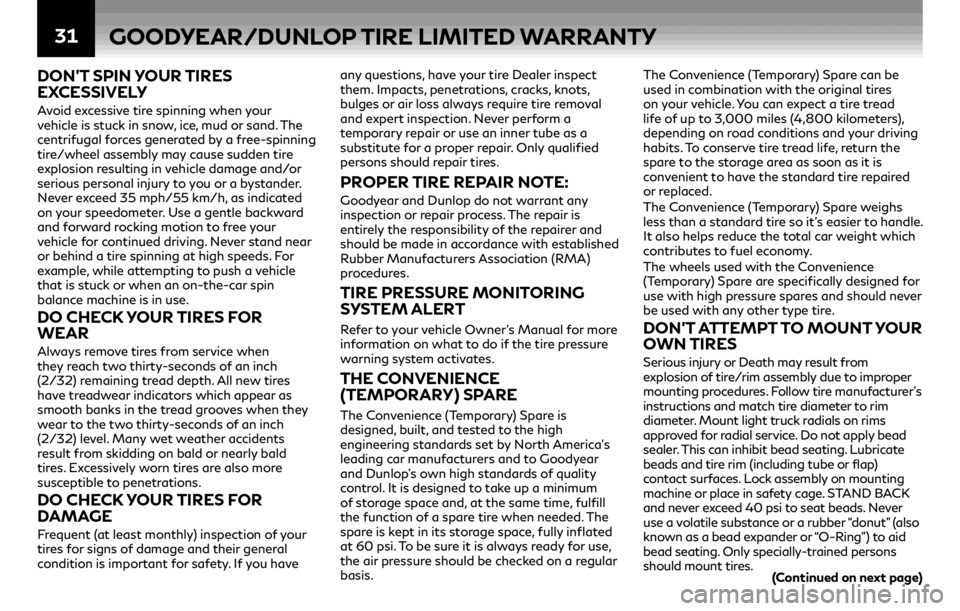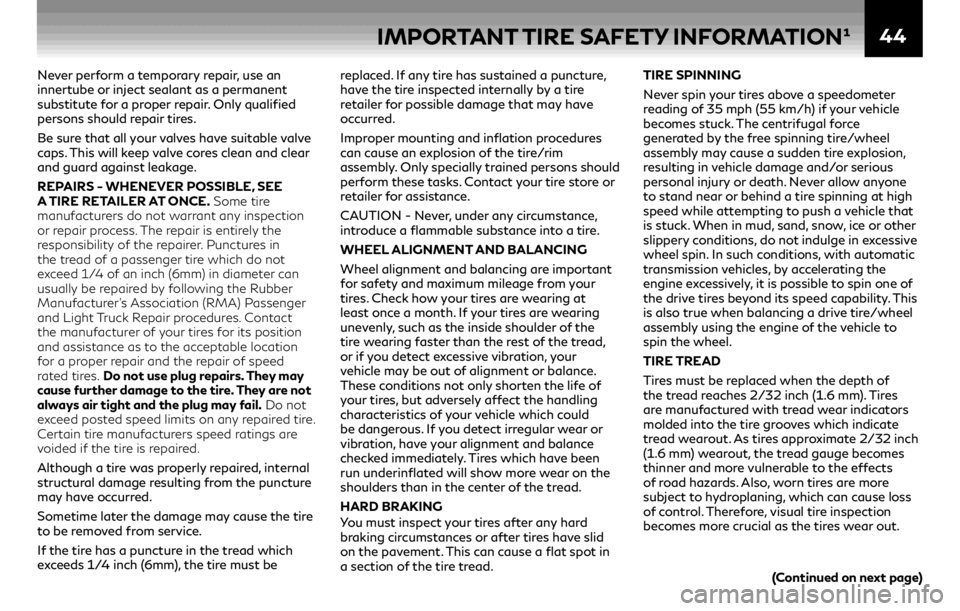check engine light INFINITI Q50 2019 Warranty Information Booklet
[x] Cancel search | Manufacturer: INFINITI, Model Year: 2019, Model line: Q50, Model: INFINITI Q50 2019Pages: 60, PDF Size: 0.25 MB
Page 34 of 60

31
DON’T SPIN YOUR TIRES
EXCESSIVELY
Avoid excessive tire spinning when your
vehicle is stuck in snow, ice, mud or sand. The
centrifugal forces generated by a free-spinning
tire/wheel assembly may cause sudden tire
explosion resulting in vehicle damage and/or
serious personal injury to you or a bystander.
Never exceed 35 mph/55 km/h, as indicated
on your speedometer. Use a gentle backward
and forward rocking motion to free your
vehicle for continued driving. Never stand near
or behind a tire spinning at high speeds. For
example, while attempting to push a vehicle
that is stuck or when an on-the-car spin
balance machine is in use.
DO CHECK YOUR TIRES FOR
WEAR
Always remove tires from service when
they reach two thirty-seconds of an inch
(2/32) remaining tread depth. All new tires
have treadwear indicators which appear as
smooth banks in the tread grooves when they
wear to the two thirty-seconds of an inch
(2/32) level. Many wet weather accidents
result from skidding on bald or nearly bald
tires. Excessively worn tires are also more
susceptible to penetrations.
DO CHECK YOUR TIRES FOR
DAMAGE
Frequent (at least monthly) inspection of your
tires for signs of damage and their general
condition is important for safety. If you have any questions, have your tire Dealer inspect
them. Impacts, penetrations, cracks, knots,
bulges or air loss always require tire removal
and expert inspection. Never perform a
temporary repair or use an inner tube as a
substitute for a proper repair. Only qualified
persons should repair tires.
PROPER TIRE REPAIR NOTE:
Goodyear and Dunlop do not warrant any
inspection or repair process. The repair is
entirely the responsibility of the repairer and
should be made in accordance with established
Rubber Manufacturers Association (RMA)
procedures.
TIRE PRESSURE MONITORING
SYSTEM ALERT
Refer to your vehicle Owner’s Manual for more
information on what to do if the tire pressure
warning system activates.
THE CONVENIENCE
(TEMPORARY) SPARE
The Convenience (Temporary) Spare is
designed, built, and tested to the high
engineering standards set by North America’s
leading car manufacturers and to Goodyear
and Dunlop’s own high standards of quality
control. It is designed to take up a minimum
of storage space and, at the same time, fulfill
the function of a spare tire when needed. The
spare is kept in its storage space, fully inflated
at 60 psi. To be sure it is always ready for use,
the air pressure should be checked on a regular
basis. The Convenience (Temporary) Spare can be
used in combination with the original tires
on your vehicle. You can expect a tire tread
life of up to 3,000 miles (4,800 kilometers),
depending on road conditions and your driving
habits. To conserve tire tread life, return the
spare to the storage area as soon as it is
convenient to have the standard tire repaired
or replaced.
The Convenience (Temporary) Spare weighs
less than a standard tire so it’s easier to handle.
It also helps reduce the total car weight which
contributes to fuel economy.
The wheels used with the Convenience
(Temporary) Spare are specifically designed for
use with high pressure spares and should never
be used with any other type tire.
DON’T ATTEMPT TO MOUNT YOUR
OWN TIRES
Serious injury or Death may result from
explosion of tire/rim assembly due to improper
mounting procedures. Follow tire manufacturer’s
instructions and match tire diameter to rim
diameter. Mount light truck radials on rims
approved for radial service. Do not apply bead
sealer. This can inhibit bead seating. Lubricate
beads and tire rim (including tube or flap)
contact surfaces. Lock assembly on mounting
machine or place in safety cage. STAND BACK
and never exceed 40 psi to seat beads. Never
use a volatile substance or a rubber “donut” (also
known as a bead expander or “O-Ring”) to aid
bead seating. Only specially-trained persons
should mount tires.
GOODYEAR/DUNLOP TIRE LIMITED WARRANTY
(Continued on next page)
Page 47 of 60

44
Never perform a temporary repair, use an
innertube or inject sealant as a permanent
substitute for a proper repair. Only qualified
persons should repair tires.
Be sure that all your valves have suitable valve
caps. This will keep valve cores clean and clear
and guard against leakage.
REPAIRS - WHENEVER POSSIBLE, SEE
A TIRE RETAILER AT ONCE.Some tire
manufacturers do not warrant any inspection
or repair process. The repair is entirely the
responsibility of the repairer. Punctures in
the tread of a passenger tire which do not
exceed 1/4 of an inch (6mm) in diameter can
usually be repaired by following the Rubber
Manufacturer’s Association (RMA) Passenger
and Light Truck Repair procedures. Contact
the manufacturer of your tires for its position
and assistance as to the acceptable location
for a proper repair and the repair of speed
rated tires. Do not use plug repairs. They may
cause further damage to the tire. They are not
always air tight and the plug may fail. Do not
exceed posted speed limits on any repaired tire.
Certain tire manufacturers speed ratings are
voided if the tire is repaired.
Although a tire was properly repaired, internal
structural damage resulting from the puncture
may have occurred.
Sometime later the damage may cause the tire
to be removed from service.
If the tire has a puncture in the tread which
exceeds 1/4 inch (6mm), the tire must be replaced. If any tire has sustained a puncture,
have the tire inspected internally by a tire
retailer for possible damage that may have
occurred.
Improper mounting and inflation procedures
can cause an explosion of the tire/rim
assembly. Only specially trained persons should
perform these tasks. Contact your tire store or
retailer for assistance.
CAUTION - Never, under any circumstance,
introduce a flammable substance into a tire.
WHEEL ALIGNMENT AND BALANCING
Wheel alignment and balancing are important
for safety and maximum mileage from your
tires. Check how your tires are wearing at
least once a month. If your tires are wearing
unevenly, such as the inside shoulder of the
tire wearing faster than the rest of the tread,
or if you detect excessive vibration, your
vehicle may be out of alignment or balance.
These conditions not only shorten the life of
your tires, but adversely affect the handling
characteristics of your vehicle which could
be dangerous. If you detect irregular wear or
vibration, have your alignment and balance
checked immediately. Tires which have been
run underinflated will show more wear on the
shoulders than in the center of the tread.
HARD BRAKING
You must inspect your tires after any hard
braking circumstances or after tires have slid
on the pavement. This can cause a flat spot in
a section of the tire tread. TIRE SPINNING
Never spin your tires above a speedometer
reading of 35 mph (55 km/h) if your vehicle
becomes stuck. The centrifugal force
generated by the free spinning tire/wheel
assembly may cause a sudden tire explosion,
resulting in vehicle damage and/or serious
personal injury or death. Never allow anyone
to stand near or behind a tire spinning at high
speed while attempting to push a vehicle that
is stuck. When in mud, sand, snow, ice or other
slippery conditions, do not indulge in excessive
wheel spin. In such conditions, with automatic
transmission vehicles, by accelerating the
engine excessively, it is possible to spin one of
the drive tires beyond its speed capability. This
is also true when balancing a drive tire/wheel
assembly using the engine of the vehicle to
spin the wheel.
TIRE TREAD
Tires must be replaced when the depth of
the tread reaches 2/32 inch (1.6 mm). Tires
are manufactured with tread wear indicators
molded into the tire grooves which indicate
tread wearout. As tires approximate 2/32 inch
(1.6 mm) wearout, the tread gauge becomes
thinner and more vulnerable to the effects
of road hazards. Also, worn tires are more
subject to hydroplaning, which can cause loss
of control. Therefore, visual tire inspection
becomes more crucial as the tires wear out.
(Continued on next page)
IMPORTANT TIRE SAFETY INFORMATION¹